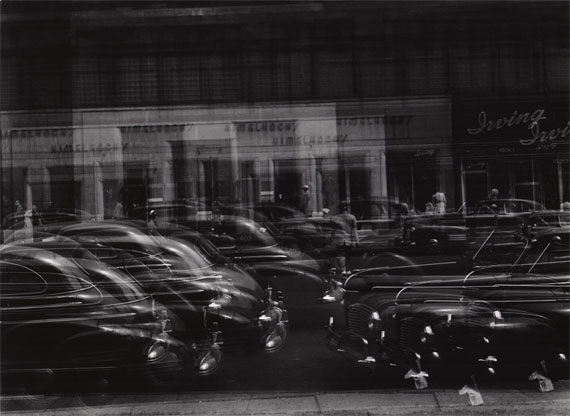
Detroit. 1943
Gelatin silver print
© The Estate of Harry Callahan
Harry Callahan »
Various Aspects
Exhibition: 21 Nov – 20 Dec 2019
Thu 21 Nov 18:00 - 20:00

Kunsthandel Jörg Maass
Rankestr. 24
10789 Berlin
+49 (0)30-2115461
kontakt@kunsthandel-maass.de
www.kunsthandel-maass.de
Mon-Fri 10-16 +
Harry Callahan
"Various Aspects"
Exhibition: 22 November – 20 December 2019
Opening: Thursday, 21 November, 6-8pm
Harry Callahan (1912 – 1999) is regarded as one of the most influential photographers of the 20th century however his works have rarely been shown in Europe. The exhibition presents a collection of circa 25 works by the American that comprise important examples of the three central themes in the photographer's work: street scenes and façade views, landscape photographs, and nude studies of his wife Eleanor. In addition to classic icons of black-and-white photography, rare color prints will be included.
Harry Callahan was a self-taught photographer. Born in Detroit in 1912, he only began to work as a photographer in 1938. Soon photography became his vocation, and only eight years later he followed László Moholy-Nagy's invitation and taught at the Institute of Design in Chicago, heading the photography department there as of 1949. In 1961 he was appointed professor of photography at the Rhode Island School of Design, Providence. With growing success and the sale of his first works, Callahan withdrew from his teaching position at the end of the 1970s and concentrated on color photography until the late 1980s, with which he had already experimented over the years.
Repeatedly, from his early to his late work, Callahan produced inspired photographs of his daily walks through the cities. They form the largest group of works in the exhibition. From 1941 to 1945 in Detroit, as of 1946 in Chicago, then in Providence, and finally on his travels through countries such as Mexico, Peru, Ireland, and Morocco. His work titles usually only refer to place and year; there are façade views with shop windows; street corners; intersections and house entrances, not always deserted, but simple and elegant, sometimes as abstract close-ups or complex double exposures, and often with an eye for moments typical of the time.
In addition, there will be a small selection of intimate landscapes on view, including the vast sandy beach of Cape Cod or the snow-covered shores of Lake Michigan in Chicago, as well as examples of very private, carefully composed nude studies of his beloved wife Eleanor, in which Callahan's strict formal principles are most evident.
In the nearly 60 years of his career, Harry Callahan created an extraordinary photographic oeuvre, always focused on the everyday aspects of his life and with a strong interest in a wide variety of photographic techniques. He experimented with line and form, the play of light and shadow, double exposure to the point of abstraction. In the early days, still in warm-toned prints, he reduces the reproduction of the wide range of tonal values over time and creates high-contrast black-and-white prints. Small-format Ektacolor prints coincide with brightly colored dye-transfer prints. In spite of his many different aspects and approaches - both in form and content - Callahan's work remains self-contained and is of great importance for the history of American photography of the 20th century.
Harry Callahan
"Various Aspects"
Ausstellung: 22. November bis 20. Dezember 2019
Eröffnung: Donnerstag, 21. November, 18 – 20 Uhr
Harry Callahan (1912 – 1999) gilt als einer der einflussreichsten Fotografen des 20. Jahrhunderts und trotzdem wurden seine Arbeiten in Europa bislang nur selten gezeigt. Die Ausstellung präsentiert eine Zusammenstellung von rund 25 Arbeiten, dabei bedeutende Beispiele der drei zentralen Themen im Werk des Fotografen: Straßenszenen und Fassadenansichten, Landschaftsfotografien und Aktstudien seiner Frau Eleanor. Zu sehen sind neben klassischen Ikonen der Schwarz-Weiß-Fotografie auch seltene farbige Abzüge.
Harry Callahan war ein Autodidakt. 1912 in Detroit geboren, begann er erst 1938 fotografisch zu arbeiten. Schnell wurde die Fotografie zur Berufung und auf Einladung László Moholy-Nagys lehrte er nur acht Jahre später am Institute of Design in Chicago, ab 1949 leitete er die dortige Abteilung für Fotografie. 1961 bekam er eine Professur für die Fotoabteilung der Rhode Island School of Design, Providence. Mit wachsendem Erfolg und dem Verkauf erster Arbeiten zog sich Callahan Ende der 1970er Jahre von seinem Lehrauftrag zurück und konzentrierte sich fortan bis in die späten 80er vor allem auf die Farbfotografie, mit der er schon über all die Jahre hinweg experimentiert hatte.
Immer wieder, von den Anfängen bis zum Spätwerk, begeistert Callahan mit Aufnahmen von seinen Streifzügen durch die Städte. Sie bilden die größte Werkgruppe der Ausstellung. Von 1941 – 1945 in Detroit, ab 1946 in Chicago, danach in Providence und zuletzt auf seinen Reisen durch Länder wie Mexiko, Peru, Irland oder Marokko. Seine Werktitel verweisen meist nur auf Ort und Jahr, zu sehen sind Fassadenansichten mit Schaufenstern; Straßenecken; Kreuzungen und Hauseingänge, nicht immer menschenleer, aber schlicht und elegant, manchmal als abstraktes Close-Up oder als komplexe Doppelbelichtung und oftmals mit einem Augenmerk auf zeittypischen Momenten.
Daneben steht sowohl eine kleine Auswahl intimer Landschaftsdarstellungen, darunter der weite Strand von Cape Cod oder das verschneite Ufer des Lake Michigan in Chicago als auch Beispiele der sehr privaten, sorgfältig komponierten Aktstudien seiner Frau Eleanor, in denen sich die formal strengen gestalterischen Ansätze Callahans am deutlichsten zeigen.
In den knapp 60 Jahren seiner Karriere schuf Harry Callahan ein außergewöhnliches fotografisches Oeuvre, stets fokussiert auf Alltäglichem aus seinem Leben und mit einem großen Interesse an den unterschiedlichsten fotografischen Techniken. Er experimentierte mit Linie und Form, dem Spiel aus Licht und Schatten, der Doppelbelichtung bis hin zur Abstraktion. In den Anfängen noch in warmtonigen Abzügen, reduziert er mit der Zeit die Wiedergabe der großen Bandbreite an Tonwerten und gestaltet kontrastreiche Schwarz-Weiß-Abzüge. In Farbe stehen kleinformatige Ektacolor-Abzüge neben leuchtend farbigen Dye-Transfers. Trotz unterschiedlicher Aspekte und Herangehensweisen – formal und inhaltlich – bleibt das Werk Callahans in sich geschlossen und ist von großer Bedeutung für die amerikanischen Fotografiegeschichte des 20. Jahrhunderts.